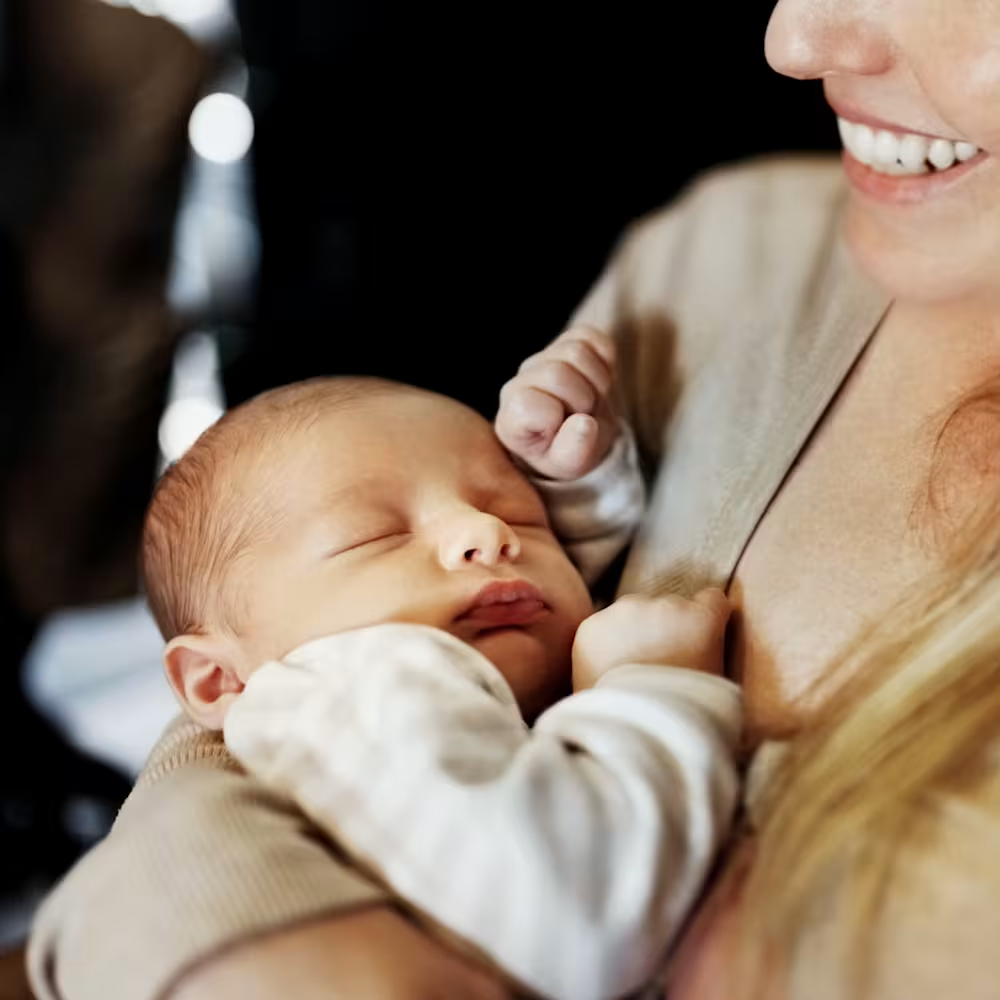Baby sleep cycles and patterns explained
Updated Nov 12, 2025

Ever wonder why your baby seems to wake up just as you drift off? That’s the magic (and madness) of baby sleep cycles. In the early months, your baby’s sleep is short and fragmented, but sleep patterns will stretch and mature as they grow. By understanding these rhythms, you can set realistic expectations, ease frustration, and help everyone get more sleep!
Understanding your baby’s sleep cycles
A baby's sleep cycle refers to the pattern a little one moves through as they drift between lighter and deeper stages of sleep. Unlike adults, whose cycles last about 90 minutes, babies zip through them much faster []. Because babies cycle through sleep so quickly, it’s common for them to wake frequently overnight, take , and experience . Those challenges are part of how their sleep develops, and understanding these unique cycles can help explain why young babies don’t typically sleep in long stretches right away — and why that’s perfectly normal.
Shorter cycles: Newborns average about 50 - 60 minutes per sleep cycle []. Because their sleep regulation systems are still developing, they often wake or stir between cycles — much more frequently than older infants or adults, whose sleep cycles are longer and more consolidated. Babies’ sleep cycles mature and lengthen through toddlerhood.
Different stages: In the first months, babies cycle mainly between active (REM) sleep and quiet (NREM) sleep, spending almost equal time in each []. Around 3 months, they begin developing three sleep stages (N1, N2, and N3) — much like that of an adult [].
Lots of transitions: Because baby sleep cycles are short and their sleep patterns are still developing, it’s normal for little ones to stir, , or even wake up briefly as they shift from one stage to the next. These mini-awakenings are part of healthy development, even if they feel disruptive to you.
Growth in progress: Over the first few months of your baby’s life, their sleep cycles gradually lengthen and the stages of sleep start to look more like an adult’s. This shift coincides with brain growth, the development of the circadian rhythm, and other milestones.
Baby sleep stages
Babies don’t just “zonk out.” Instead, they cycle through different states of sleep that look and feel different.
Active sleep (REM)
Active sleep, or REM sleep, is the lighter, dream-filled stage of sleep. Newborns spend much of their total sleep in this stage as their brains rapidly develop and process new experiences. Your baby might , smile, grunt, breathe noisily, or move their eyes under closed lids. It can look restless, but those movements are normal and even essential for brain development.
Quiet sleep (NREM)
Quiet sleep, or NREM sleep, is deeper, more restorative sleep. Your baby lies still, their breathing is steady, and it’s often harder to wake them. Newborns experience one stage of NREM, but by around 3 - 4 months old, their sleep matures into three NREM stages []:
N1: Light sleep consisting of alpha waves and low-amplitude mixed-frequency activity
N2: Intermediate sleep, including sleep spindles and K-complexes
N3: Delta waves, or the deepest, most restorative stage of sleep
How your baby’s sleep cycles change with age
So how do all these short cycles and shifting stages play out in real life? Just like your baby outgrows onesies, their sleep stages don’t stay the same for long. Here’s what you can expect as your baby’s sleep patterns mature:
Newborns (0 - 8 weeks)
Sleep is fragmented and spread pretty evenly between . Because their circadian rhythms are still developing, newborns tend to sleep in short cycles around the clock, without a clear preference for nighttime rest. This is normal, even if it makes for exhausted parents!
Newborns (8 - 12 weeks)
Around 2 months old, babies start producing melatonin and cortisol — hormones that help regulate the body clock []. This biological shift marks the beginning of a clearer separation between day and night. You may notice longer nighttime stretches and more wakefulness during the day, especially with a consistent routine and exposure to natural light.
3 - 5 months
As babies grow, their sleep becomes more organized. Sleep cycles gradually lengthen, and circadian rhythms begin to favor longer stretches at night. Around this age, many experience what’s often called the “.” It isn’t a true regression, but rather a reflection of maturing sleep patterns. As the brain starts organizing sleep into distinct light and deep stages, babies may wake more fully between cycles and need extra support to settle back to sleep.
By 6 months
Most babies’ sleep architecture has matured enough to link cycles more reliably both day and night with a solid foundation (think: , sufficient daytime calories, and skills), many little ones start stretching into longer, more consistent blocks of rest.
Baby sleep cycle changes by age
Newborns don’t sleep in long, predictable blocks the way adults do. Their sleep cycles are shorter, and the structure changes quickly in the first 6 months as their brains and bodies mature. Here’s how the progression goes over the first year of life:
Age | Sleep cycle characteristics | Notable changes |
Newborn (0 - 8 weeks) | Sleep cycles are short and evenly split between REM (active) and NREM (quiet). | Frequent waking around the clock is healthy and expected because circadian rhythms haven’t developed yet and newborns need to wake often to eat. |
Newborn (8 - 12 weeks) | Babies start producing melatonin and cortisol — hormones that help regulate the body clock | Clearer separation between day and night. Possibly longer nighttime stretches and more wakefulness during the day, especially with a consistent routine and exposure to natural light. |
3 - 5 month=s | Sleep stages begin to mature and look a little more like an adult’s.
| REM starts to decrease, and NREM splits into three separate stages (N1, N2, and N3). Babies may wake at the end of a sleep cycle and call out for assistance to get back to sleep. |
6 months and older | Sleep cycles have matured and gradually lengthen with age. | Many babies start to link cycles and return to sleep more easily, especially if independent sleep habits have been established. |
How REM sleep develops in babies
Babies start life with a lot of REM sleep, and it’s normal for them to wake frequently, both because of their sleep cycles and because they . During REM sleep, it may look like they’re twitching, , or breathing noisily while dreaming. Over the first year, the amount of REM gradually decreases as their sleep matures. Here’s how it typically unfolds:
Newborns (0 - 2 months): About 50% of a newborn’s sleep is REM []. They often fall directly into REM instead of easing in through NREM in short cycles, frequently waking and napping.
3 - 4 months: REM sleep begins to decrease, and sleep cycles start to resemble adult sleep stages. Babies spend more time in quiet (NREM) sleep, split into three distinct phases.
6 months and older: REM continues to decline, eventually steadying by toddlerhood [].
Why REM sleep matters for your baby
All that wiggling and twitching during REM might look restless, but it’s actually your baby’s brain hard at work. Here’s why REM is one of the most important sleep stages for your baby’s growth and development:
Brain development: REM is critical for rapid brain growth and the formation of neural connections [].
Cognitive and emotional growth: This stage supports memory, learning, and processing emotions — all big jobs for your developing baby [].
Factors that can affect baby sleep patterns
Every baby is different, but several key factors can shape how (and how smoothly) they move through each sleep cycle for optimal rest and growth:
Age: cycles are short and unpredictable, while older babies gradually settle into longer, more regular stretches of sleep.
Feeding schedule: Hunger is one of the biggest reasons for of life. As babies grow and take in more calories during the day, their sleep often consolidates.
Sleep environment: Light timing matters. Bright light before bedtime can delay sleep onset; early-morning light can cue earlier wake-ups; and light during naps often shortens nap length. A dark, quiet, comfortably room supports deeper, more consolidated sleep, while sudden or loud noises can disrupt it.
Routines: Consistent bedtime routines help signal to your baby’s body clock that it’s time for sleep, making it easier to fall (and stay) asleep.
Sleep onset associations: If your baby is used to falling asleep with rocking, feeding, or another cue, they may expect the same help to fall back asleep between cycles [].
Developmental milestones: Rolling, crawling, , or a growth spurt may disrupt sleep patterns temporarily as your baby’s brain and body are focused on practicing new skills.
Tips to support healthy baby sleep patterns
You can’t control every twist and turn of your baby’s sleep cycle, but a few intentional strategies can make a big difference in getting restful sleep and making it easier for your little one to fall back to sleep between cycles.
Follow an age-appropriate sleep schedule: Sleep needs change fast. For younger babies, follow , and for older ones, aim for a consistent daily rhythm.
Watch for sleepy cues: For younger babies, signals like yawning or zoning out mean it’s time to rest. Older babies often do better on a consistent schedule instead.
Aim for a consistent wake-up time (3mo+): Waking up within the same 30-minute window each morning helps regulate your baby’s circadian rhythms.
Create a consistent bedtime routine: Repeating the same steps each night — like bath, PJs, storytime, then bed — helps signal to your baby that it’s time to sleep.
Provide a dark, quiet environment: Keep nights and calm and dark to encourage longer stretches of rest.
Transition to a set schedule when appropriate: By around 6 months (and more reliably between 8 - 9 months), babies are often ready to move from into a more predictable set schedule. A regular bedtime and consistent naps can help babies link cycles more smoothly and sleep for longer stretches.
When to talk to your pediatrician
Every baby’s development is unique, but there are times when it helps to check in with your pediatrician. As always, trust your intuition — you are the top expert on your baby, after all.
Extreme fussiness or exhaustion: When your baby seems overly tired during the day, even when they’re logging enough hours in bed.
Concerns about growth or development: Poor sleep paired with feeding issues or slow weight gain is always worth discussing.
Unusual breathing or sleep movements: , pauses in breathing, or frequent jerking beyond normal may need evaluation.
Persistent trouble sleeping: If you’re concerned about your baby’s sleep, a pediatrician can rule out any underlying medical concerns that may be impacting their ability to fall asleep and stay asleep.
If you’re looking for guidance on schedule adjustments and independent sleep skills, Huckleberry can help. With Huckleberry Premium, you can submit for a Sleep Plan that’s tailored to your child and parenting preferences.
Takeaway
Baby sleep cycles are shorter: Newborns average about 50 - 60 minutes per sleep cycle, gradually lengthening toward 90 minutes by toddlerhood.
Stages shift with age: Newborns cycle between active (REM) and quiet (NREM) sleep, but by 3 - 4 months, they begin moving through four NREM stages, like adults do.
Patterns mature over time: Fragmented newborn sleep begins to consolidate by 3 - 4 months. By around 6 months and beyond, many babies can develop longer, more predictable stretches — especially if they’ve had practice with independent sleep skills and age-appropriate routines.
Understanding makes it easier: Knowing how baby sleep cycles work sets realistic expectations, eases frustration, and helps you support your child’s unique sleep journey.
Baby sleep cycles FAQ
Share article:
Note: The content on this site is for informational purposes only and should not replace medical advice from your doctor, pediatrician, or medical professional. If you have questions or concerns, you should contact a medical professional.
9 Sources
Table of Contents
Share article:





